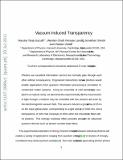| dc.contributor.author | Chen, Wenlan | |
| dc.contributor.author | Landig, Renate | |
| dc.contributor.author | Vuletic, Vladan | |
| dc.contributor.author | Tanji-Suzuki, Haruka | |
| dc.contributor.author | Simon, Jonathan | |
| dc.date.accessioned | 2014-08-07T15:22:20Z | |
| dc.date.available | 2014-08-07T15:22:20Z | |
| dc.date.issued | 2011-08 | |
| dc.date.submitted | 2011-05 | |
| dc.identifier.issn | 0036-8075 | |
| dc.identifier.issn | 1095-9203 | |
| dc.identifier.uri | http://hdl.handle.net/1721.1/88580 | |
| dc.description.abstract | Photons are excellent information carriers but normally pass through each other without consequence. Engineered interactions between photons would enable applications as varied as quantum information processing and simulation of condensed matter systems. Using an ensemble of cold atoms strongly coupled to an optical cavity, we found that the transmission of light through a medium may be controlled with few photons and even by the electromagnetic vacuum field. The vacuum induces a group delay of 25 nanoseconds on the input optical pulse, corresponding to a light velocity of 1600 meters per second, and a transparency of 40% that increases to 80% when the cavity is filled with 10 photons. This strongly nonlinear effect provides prospects for advanced quantum devices such as photon number–state filters. | en_US |
| dc.description.sponsorship | National Science Foundation (U.S.) (Grant PHY-0855052) | en_US |
| dc.description.sponsorship | National Science Foundation (U.S.) (Grant PHY-0551153) | en_US |
| dc.description.sponsorship | United States. Army Research Office (Defense Advanced Research Projects Agency. QuASAR Program) | en_US |
| dc.language.iso | en_US | |
| dc.publisher | American Association for the Advancement of Science (AAAS) | en_US |
| dc.relation.isversionof | http://dx.doi.org/10.1126/science.1208066 | en_US |
| dc.rights | Article is made available in accordance with the publisher's policy and may be subject to US copyright law. Please refer to the publisher's site for terms of use. | en_US |
| dc.source | arXiv | en_US |
| dc.title | Vacuum-Induced Transparency | en_US |
| dc.type | Article | en_US |
| dc.identifier.citation | Tanji-Suzuki, H., W. Chen, R. Landig, J. Simon, and V. Vuletic. “Vacuum-Induced Transparency.” Science 333, no. 6047 (September 1, 2011): 1266-1269. | en_US |
| dc.contributor.department | Massachusetts Institute of Technology. Department of Physics | en_US |
| dc.contributor.department | Massachusetts Institute of Technology. Research Laboratory of Electronics | en_US |
| dc.contributor.department | MIT-Harvard Center for Ultracold Atoms | en_US |
| dc.contributor.mitauthor | Chen, Wenlan | en_US |
| dc.contributor.mitauthor | Landig, Renate | en_US |
| dc.contributor.mitauthor | Vuletic, Vladan | en_US |
| dc.relation.journal | Science | en_US |
| dc.eprint.version | Author's final manuscript | en_US |
| dc.type.uri | http://purl.org/eprint/type/JournalArticle | en_US |
| eprint.status | http://purl.org/eprint/status/PeerReviewed | en_US |
| dspace.orderedauthors | Tanji-Suzuki, H.; Chen, W.; Landig, R.; Simon, J.; Vuletic, V. | en_US |
| dc.identifier.orcid | https://orcid.org/0000-0003-1521-5365 | |
| dc.identifier.orcid | https://orcid.org/0000-0002-9786-0538 | |
| mit.license | PUBLISHER_POLICY | en_US |
| mit.metadata.status | Complete | |
